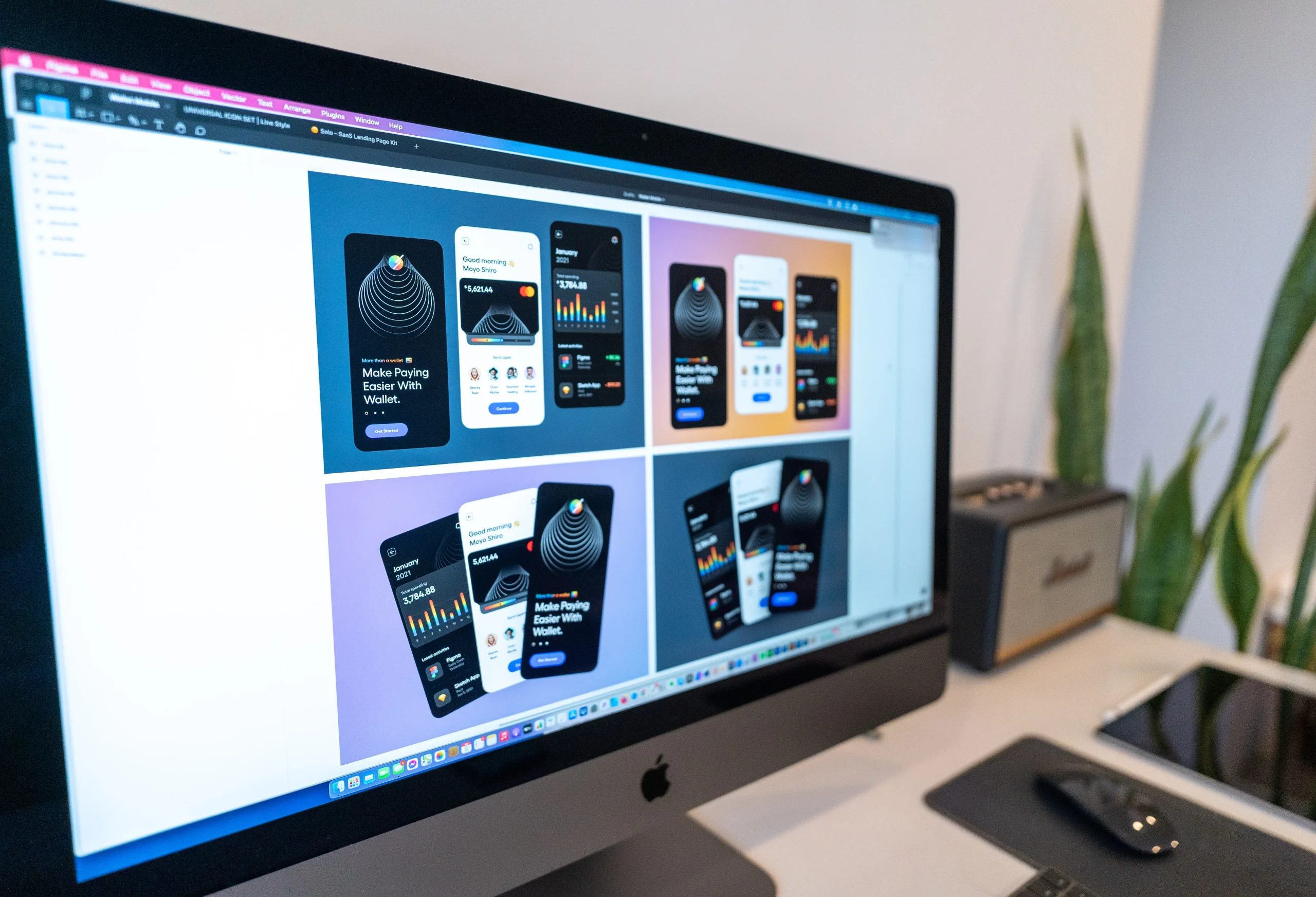In the world of design, two acronyms stand out prominently— UI vs UX. UI (User Interface) and UX (User Experience) are integral components of the design process, often used interchangeably but representing distinct aspects. In this blog, we’ll delve into the nuances of UI vs UX, shedding light on their differences and highlighting their collaborative role in creating exceptional digital experiences.
Key Takeaways
- UI and UX are complementary yet distinct elements in design.
- UI focuses on the visual aspects of a product, emphasizing aesthetics and interactivity.
- UX encompasses the overall user journey, emphasizing usability, accessibility, and user satisfaction.
- Both UI vs UX play crucial roles in crafting a seamless and delightful user experience.
- Collaboration between UI vs UX designers is essential for optimal results.
UI: Aesthetic Appeal Meets Functionality
User Interface (UI) design primarily deals with the look and feel of a digital product. It involves crafting visually appealing interfaces that seamlessly blend aesthetics with functionality. UI designers are responsible for creating elements such as buttons, menus, and color schemes, ensuring a visually engaging and cohesive design.
As users interact with a product, the UI design becomes their first point of contact. Clarity, consistency, and intuitive navigation are paramount in UI design, enhancing the overall user experience. The goal is to create a visually appealing interface that not only captures attention but also facilitates smooth interactions.
Key Principles of UI Design
-
- Consistency in design elements fosters a sense of familiarity.
- Intuitive navigation ensures users can easily understand and use the interface.
- Effective use of color and typography enhances visual hierarchy.
- Attention to detail contributes to a polished and professional appearance.
- Responsiveness ensures the interface adapts to various devices and screen sizes.
In addition to visual appeal, UI designers must consider the emotional response elicited by the design. Engaging users emotionally through thoughtful design elements contributes to a more memorable and positive interaction. Moreover, UI design extends beyond the digital realm, influencing the perception of a brand’s identity and values.
UX: Orchestrating Seamless User Journeys
User Experience (UX) design goes beyond the surface, focusing on the entire user journey. It involves understanding user behaviors, needs, and motivations to create a product that not only looks good but also functions seamlessly. UX designers are concerned with aspects such as information architecture, usability, and overall user satisfaction.
A successful UX design ensures that users can achieve their goals efficiently and enjoy a positive overall experience. It involves research, testing, and continuous improvement to address user pain points and refine the product based on real-world user feedback.
Key Principles of UX Design
-
- User research provides insights into user behaviors and preferences.
- Usability testing helps identify and rectify potential issues in the user journey.
- Accessibility ensures that the product is usable by a diverse range of users.
- Persona creation helps designers empathize with target users.
- Iterative design allows for continuous improvement based on user feedback.
UX design is a holistic approach that considers the entire user ecosystem. From the moment a user discovers a product to post-interaction reflections, every touchpoint contributes to the overall user experience. By prioritizing the user journey, UX designers aim to create experiences that resonate with users on a deep and meaningful level.
Collaborative Synergy: UI vs UX in Harmony
While UI and UX represent distinct aspects of design, their collaboration is crucial for creating exceptional digital experiences. The synergy between a visually appealing UI and a seamlessly orchestrated UX results in a product that not only looks good but also functions intuitively, meeting the needs and expectations of the users.
The Collaborative Process
-
- Wireframing: UI vs UX designers collaborate on creating wireframes, outlining the structure and functionality of the interface.
- Prototyping: UI designers bring wireframes to life with visual elements, while UX designers ensure a smooth and intuitive user flow.
- User Testing: Both UI vs UX designers actively participate in user testing, gathering feedback to refine and enhance the design.
- Continuous Communication: Regular communication and feedback loops ensure that UI and UX designers remain aligned throughout the design process.
- Iterative Refinement: The collaborative process is iterative, allowing for continuous improvement based on user insights and design enhancements.
The collaborative nature of UI and UX design goes beyond individual tasks; it’s about fostering a shared understanding of user needs and business goals. Regular workshops and brainstorming sessions ensure that both teams contribute ideas and insights, resulting in a comprehensive and user-centric design.
The Impact on User Perception
The distinction between UI and UX may seem subtle, but its impact on user perception is profound. A visually appealing UI captures attention, making a positive first impression, while a well-crafted UX ensures that users have a smooth and satisfying experience, fostering long-term engagement and loyalty.
User Perception Takeaways
-
- Visual Appeal Matters: Users are drawn to products with visually appealing interfaces, making UI crucial for capturing attention.
- Functionality is Key: Aesthetics alone are not enough; a seamless user experience is essential for user satisfaction and retention.
- First Impressions Count: Users form opinions quickly; a well-designed UI and UX contribute to positive first impressions.
- Consistency Builds Trust: Consistent design elements across the UI and UX foster trust and familiarity.
- User-Centric Approach: Prioritizing user needs in both UI and UX design leads to products that resonate with the target audience.
User perception is a dynamic interplay between the immediate visual impact and the lasting impression left by the overall user experience. A harmonious blend of UI and UX ensures that users not only enjoy the aesthetics of a product but also find it functional, intuitive, and aligned with their expectations.
Addressing Common Misconceptions
Misconceptions often arise, leading to confusion about the roles of UI and UX. It’s essential to address these misconceptions to foster a better understanding of how UI and UX work together to create exceptional digital products.
Common Misconceptions
-
- UI Equals UX: While related, UI and UX are distinct aspects of design, with UI focusing on visuals and UX on the overall user journey.
- Aesthetics Trump Functionality: UI design goes beyond aesthetics; it must also prioritize functionality and usability.
- UX is Only About Research: While research is a crucial aspect of UX, it encompasses the entire user journey, from discovery to post-interaction satisfaction.
- UI/UX is a One-Time Task: Design is an iterative process, and both UI and UX require continuous refinement based on user feedback and evolving trends.
- Only Designers are Involved: Collaboration across departments, including development and marketing, is essential for a holistic design approach.
Misconceptions about UI and UX often stem from oversimplifications or a lack of exposure to the intricacies of the design process. Educating stakeholders and team members about the multifaceted nature of design ensures a more informed and collaborative approach to UI and UX initiatives.
Quotable Wisdom: Experts on UI vs UX
Let’s hear from industry experts who have navigated the realms of UI and UX design. Their insights shed light on the importance of both aspects and the collaborative effort required to create outstanding digital experiences.
Expert Quotes
-
- Steve Jobs: “Design is not just what it looks like and feels like. Design is how it works.”
- Don Norman: “The best design is invisible. It’s only when it falls short that it draws attention.”
- Jesse James Garrett: “User experience is everything. It always has been, but it’s undervalued and underinvested in. If you don’t know user-centered design, study it. Hire people who know it. Obsess over it. Live and breathe it. Get your whole company on board.”
These insights from industry pioneers emphasize the holistic nature of design, where aesthetics and functionality are inseparable. Recognizing the symbiotic relationship between UI and UX, as articulated by these experts, reinforces the collaborative mindset needed for successful design outcomes.
Emerging Trends in UI vs UX Design
The design landscape is ever-evolving, with new trends shaping the way we approach UI and UX. Staying informed about these trends is crucial for designers aiming to create forward-thinking and innovative digital experiences.
Emerging Trends
-
- Dark Mode: Increasingly popular, dark mode enhances visual appeal and reduces eye strain in low-light conditions.
- Microinteractions: Subtle animations and feedback elements contribute to a more engaging and interactive user experience.
- Voice User Interface (VUI): The rise of voice-controlled devices emphasizes the importance of designing for voice interactions.
- Neumorphism: A design trend blending skeuomorphism and flat design, creating interfaces with soft shadows and highlights.
- Augmented Reality (AR) and Virtual Reality (VR): The integration of AR and VR elements for immersive user experiences.
These emerging trends not only reflect advancements in technology but also signal a shift in user expectations. Designers who embrace and adapt to these trends can create experiences that feel contemporary and resonate with the preferences of modern users.
The Evolution of UI vs UX: Looking Back and Ahead
As technology advances and user expectations evolve, UI and UX design continue to adapt. Looking back at the evolution of design provides insights into where UI and UX might be headed in the future.
Evolutionary Highlights
-
- Early Web Design: Basic interfaces with limited interactivity and visual appeal.
- Rise of Mobile Design: The shift to mobile devices led to the importance of responsive and mobile-first design.
- Minimalism and Flat Design: Streamlined and clean designs gained popularity for improved usability.
- Inclusive Design: A growing emphasis on creating designs that cater to a diverse range of users.
- The Future: Anticipated trends include increased personalization, enhanced AI integration, and a focus on sustainability in design.
Looking ahead, the evolution of UI and UX design is likely to be shaped by technological innovations, changing user behaviors, and an increased emphasis on ethical and sustainable design practices. Designers who stay attuned to these factors can anticipate and navigate the evolving design landscape effectively.
The Future of UI vs UX Collaboration
As we navigate digital design, the future of UI/UX collaboration holds exciting possibilities. With advancements in technology, increased user expectations, and a growing emphasis on inclusive design, the collaboration between UI and UX is set to become even more pivotal.
Future Considerations
-
- AI Integration: The role of artificial intelligence in personalizing user experiences and predicting user needs.
- Inclusive and Ethical Design: A focus on creating designs that cater to diverse user groups and prioritize ethical considerations.
- Cross-Platform Consistency: Ensuring a seamless experience across various devices and platforms.
- Data-Driven Design: Leveraging data analytics to inform design decisions and enhance user experiences.
- Collaborative Tools: Continued advancements in collaborative design tools that facilitate seamless communication between UI and UX teams.
Collaboration between UI and UX designers is not static; it evolves in tandem with technological advancements and changing user expectations. The future promises a deeper integration of AI, a heightened focus on inclusivity, and more sophisticated tools that enhance collaboration, ultimately leading to the creation of more compelling and user-centric digital experiences.
Key Takeaways
The dynamic interplay between UI and UX is crucial for creating a seamless and delightful user experience. While UI focuses on the aesthetics and visual elements, UX delves into the overall user journey and satisfaction. A harmonious collaboration between these two facets is essential to develop digital products that not only look stunning but also function intuitively, meeting the diverse needs of users.
For further insights and assistance in navigating the intricacies of UI and UX design, feel free to reach out to Wecreate Digital Agency. Wecreate is an award-winning, all-round digital marketing agency with offices in Amsterdam, Hong Kong, Singapore, Bali and Philippines. Our expert team is ready to address any queries and collaborate with you to elevate your digital presence. Contact us today for a transformative approach to UI/UX design that puts your users at the forefront of innovation.




